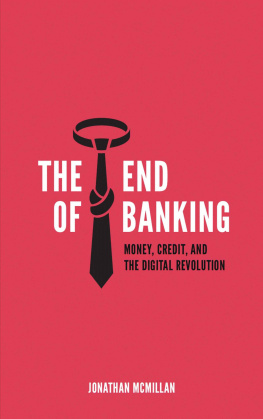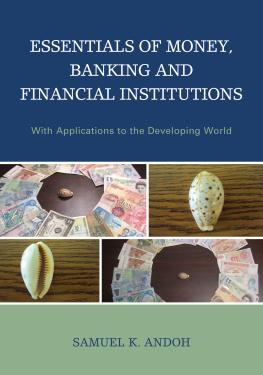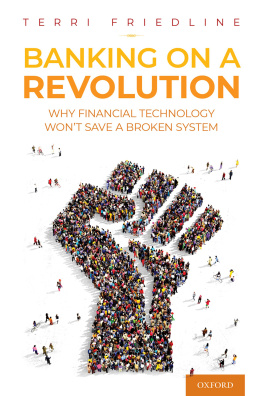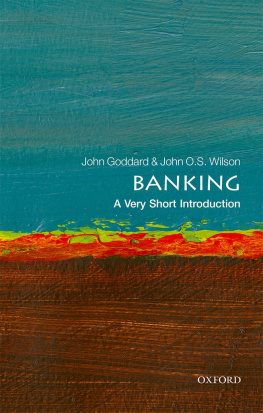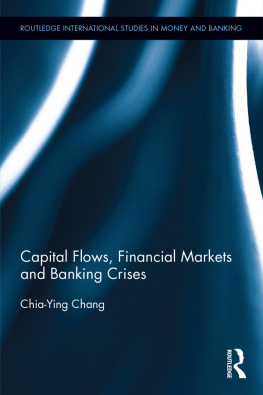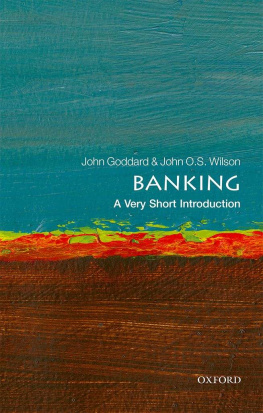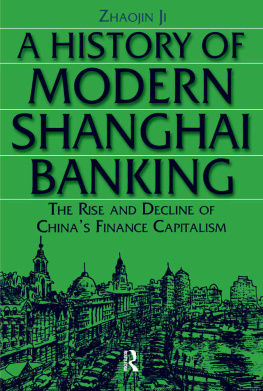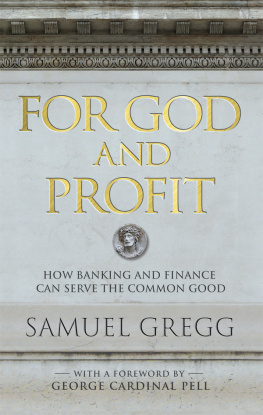The End of Banking
Money, Credit, and the digital Revolution
Jonathan McMillan
Copyright 2014 by Jonathan McMillan
All rights reserved.
Published by
Zero/One Economics GmbH
Zurich, Switzerland
Cover, book design, and illustrations by Marcel Bamert.
Index by Sylvia Coates
The use of general descriptive names, registered names, trademarks, etc. in this book does not imply, even in the absence of specific statement, that such names are exempt from the relevant protective laws and regulations and therefore free for general use. All quotations in this book are used for illustrative or critical purposes only, and the words quoted remain the copyright of the respective copyright holders.
Although the author and publisher have made every effort to ensure that the information in this book was correct at press time, the author and publisher do not assume and hereby disclaim any liability to any party for any loss, damage, or disruption caused by errors or omissions, whether such errors or omissions result from negligence, accident, or any other cause. The author and publisher have no responsibility for the persistence or accuracy of URLs for any websites referred to in this book and do not guarantee that any content on such websites is, or will remain, accurate or appropriate.
For more information about this book, visit:www.endofbanking.org
ISBN-13 978-3-9524385-2-7 (epub)
First ebook Edition, 2015
Table of Contents
List of Illustrations
Figure 2.1 Stylized balance sheet
Figure 2.2 The balance sheet of a technically insolvent company
Figure 2.3 The balance sheet of Sarah's coffee roasting business
Figure 2.4 Money creation by traditional banking: part one
Figure 2.5 Money creation by traditional banking: part two
Figure 2.6 Money destruction by traditional banking
Figure 4.1 The liabilities of banks and of shadow banking institutions over time in percentage of GDP
Figure 5.1 The securitization chain
Figure 5.2 Shadow banking : the rep o channel
Figure 5.3 Shadow banking : the repo and the ABCP channel
Figure 5.4 Money creation in shadow banking : part one
Figure 5.5 Money creation in shadow banking : part two
Figure 5.6 Money destruction in shadow banking
Figure 9.1 Illustration of the updated solvency rule
Table 9.2 The concept of the worst financial state exemplified
Figure 11.1 A financial system with banking: part one
Figure 11.2 A financial system without banking: part one
Figure 11.3 A financial system with banking: part two
Figure 11.4 A financial system without banking: part two
List of Acronyms
ABCP asset-backed commercial paper
ABS asset-backed security
AIG American Insurance Group
CDO collateralized debt obligation
CDS credit default swap
ETF exchange-traded fund
FDIC Federal Deposit Insurance Corporation
FFA Federal Financial Authority
GDP gross domestic product
LIBOR London Interbank Offered Rate
MBS mortgage-backed security
MMMF money market mutual fund
OTC over-the-counter
QIS quantitative impact study
SEC U.S. Securities and Exchange Commission
SPV special purpose vehicle
TARP Troubled Asset Relief Program
Preface
A lot of books claim to explain the problems with banking, but most of them fail to reach the essence of the matter. Some authors interpret the financial crisis of 200708 as a story of greedy bankers scamming innocent widows and orphans. Scandalous stories can be entertaining to read, but identifying unchangeable aspects of human nature as the root of all evil falls short. It will not prevent the next financial crisis. Neither will minor regulatory patches, which have been the standard answer to banking crises by many economists and politicians. The current problems with banking are deeply entrenched within the financial system. Fundamental change is needed, and some economists have indeed reverted to radical reform proposals that were originally developed decades ago. However, while old theories have valuable lessons to teach, we found that old solutions fail to solve todays problems with banking.
Disappointed by the existing approaches toward banking and its problems, we decided to write this book. It proved to be a formidable challenge. The difficulty lies in the elusiveness of banking. Banking can appear in various forms. By generalizing our understanding of it, we have been able to identify the basic financial techniques that are common to all forms of bankingwhether it is performed by medieval goldsmiths or by todays managers at investment banks. We found that banking was a sensible way to organize the financial system in the industrial age, but it got out of control with the rise of information technologies. The financial crisis of 200708 was an inevitable consequence of banking in the digital age.
Revealing the deficiencies of todays banking system is only a first step. The main purpose of this book is to show how to restore a functioning financial system. How the financial system is organized is of an importance that cannot be exaggerated. The organization of the financial system affects the stability, the productivity, and the distributive justice of the economy. This is why the largest part of this book is concerned with outlining a financial system for the digital age.
Although The End of Banking is primarily addressed to our colleagues in economics and finance, any interested reader can follow the arguments. We have avoided jargon as much as possible and have explained banking and its problems in a nontechnical way. Nevertheless, reading this book remains an intellectual journey, and we advise you to read it from start to finish if you have no background in economics or finance. For readers familiar with the matter, the first part is more of a refresher that might be skipped.
This book is the result of careful deliberation, and we have chosen its title for a good reason. Once the transformative potential of the digital revolution is understood, traditional ways to organize the financial system no longer appear sustainable. Calling for the end of banking might be considered presumptuous. We hope to convince you on the following pages that it is nothing but necessary.
Jonathan McMillan
August, 2014
Introduction
A financial system without banking is both desirable and possible. While banking once was a useful activity that provided essential economic functions, the digital revolution turned the tables. Banking slipped out of control because information technology rendered banking regulation ineffective. The financial crisis of 200708 heralded a new age of unconstrained banking. But the effects of the digital revolution on the financial system are twofold. We not only lost control over banking in the digital age, we also no longer need it. Information technology offers new possibilities that make banking redundant. Ending banking will mark the beginning of a modern financial system.
Calling for the end of banking might sound too simplistic to solve todays problems in the financial system. Such a notion likely stems from a vague definition of banking. Some label all activities undertaken by banks as banking. Others think of banking as a bundle of financial services such as asset management or securities underwriting. We adopt a macroeconomic perspective and define banking as the creation of money out of credit. This might sound odd to people unfamiliar with this field. Rest assured that we will explain banking in great detail. For the moment, it is important to note that banking is not confined to the institution that we call the bank, and not all the activities banks are engaged in are banking. Banking is not a business model, but a way to organize the financial system.
Next page
